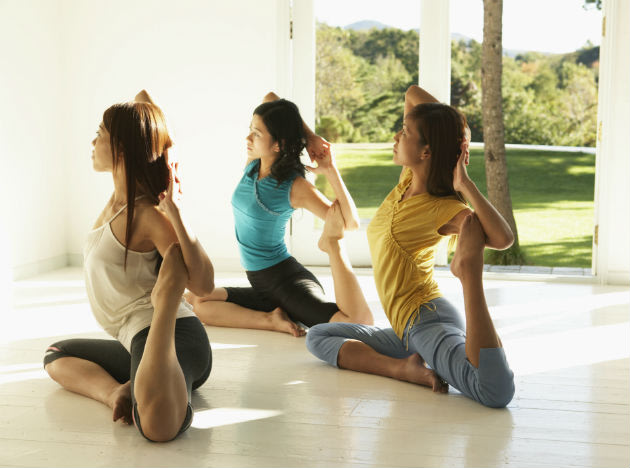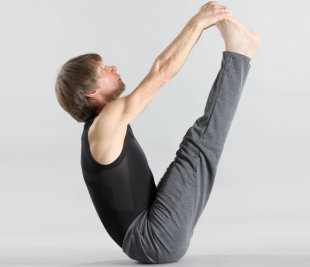When it comes to getting the perfect body, no workout technique is more effective than yoga.
While it can be used to achieve ideal health, yoga can also aid in sculpting the abs perfectly. Here are some yoga postures to help you achieve the perfect body you dream of. All you need is a yoga mat to get you started.
1. Hand and Knees Balance
2. Downward-Facing Dog Pose (Adho Mukha Svanasana)
3. Plank Pose (Vashisthasana)
5. Hand to Foot Pose (Padahastasana)
6. Half-Wheel Pose (Ardha Chakrasana)
a. Step One
Stand straight on the mat, with your arms extended above your head.
b. Step Two
While inhaling deeply, gradually bend backwards with your arms still outstretched and you fingers interlocked.
c. Step Three
As you feel the tension in your ribs, bend as far backwards as possible forming an arch with your spine.
d. Step Four
Hold this position for 5 counts and return to your starting position.
e. Step Five
Once you are back to your starting position, lower your arms and let your body relax. Rest for 10 counts and repeat.
1. Hand and Knees Balance
The following posture tests core strengths, builds muscular mass, improves balance while building your abs at the same time.
a. Step One
Rest your body on all fours, with your hands placed directly under your shoulders and your knees resting directly underneath your hips.
b. Step Two
Extend your right leg out and keep it straight on the floor.
c. Step Three
Lift your right leg to the same height as your hips. Keep them in the same alignment as before.
d. Step Four
Lift your left arm to the shoulder level and keep it outstretched.
e. Step Five
Balance your body weight on the right arm and left leg and keep your spine straight. Hold this position for 10 counts.
f. Step Six
Exhale as you return to your starting position. Rest for 5 counts and repeat the posture with the other leg.
Rest your body on all fours, with your hands placed directly under your shoulders and your knees resting directly underneath your hips.
b. Step Two
Extend your right leg out and keep it straight on the floor.
c. Step Three
Lift your right leg to the same height as your hips. Keep them in the same alignment as before.
d. Step Four
Lift your left arm to the shoulder level and keep it outstretched.
e. Step Five
Balance your body weight on the right arm and left leg and keep your spine straight. Hold this position for 10 counts.
f. Step Six
Exhale as you return to your starting position. Rest for 5 counts and repeat the posture with the other leg.
2. Downward-Facing Dog Pose (Adho Mukha Svanasana)
This posture is great for building resistance in the abdominal muscles, along with strengthening the spine.
a. Step One
Rest your body on all fours, with your hands underneath your shoulders and knees aligned under the hips.
b. Step Two
Keep your hands and feet on the ground and push your hips outward, keeping your feet straight.
c. Step Three
Balance your weight on the forearms and fingers and keep your head hung low.
d. Step Four
Balance your weight in such a way that the bulk is removed from the arms, thereby reducing muscular strain.
e. Step Five
Keep your legs as straight as possible and your heels flat on the floor.
f. Step Six
Exhale as you relax your posture and gradually sink to your starting position. Rest for 5 counts and repeat.
Rest your body on all fours, with your hands underneath your shoulders and knees aligned under the hips.
b. Step Two
Keep your hands and feet on the ground and push your hips outward, keeping your feet straight.
c. Step Three
Balance your weight on the forearms and fingers and keep your head hung low.
d. Step Four
Balance your weight in such a way that the bulk is removed from the arms, thereby reducing muscular strain.
e. Step Five
Keep your legs as straight as possible and your heels flat on the floor.
f. Step Six
Exhale as you relax your posture and gradually sink to your starting position. Rest for 5 counts and repeat.
3. Plank Pose (Vashisthasana)
This yoga posture can be continued from the Downward-Facing Dog pose discussed earlier. This enhances resistance in the abdominal muscles and also improves the strength in the arms and shoulders.
a. Step One
Having assumed the Downward Facing Dog Pose, adjust your body weight such that your arms are directly below your shoulders.
b. Step Two
Lower your hips till your torso is in a straight line with the legs.
c. Step Three
Distribute the weight among your toes and hands such that you can comfortably rest in this position without straining your limbs.
d. Step Four
Keep your neck in the same line with the rest of your body and hold this position for 10 counts.
e. Step Five
Exhale and relax your posture gradually to lie on your stomach, on the mat.
4. The Boat Pose (Navasana)
This posture is excellent in building abdominal core strengths and creating greater muscular resistance among the legs, hamstrings and spine.
Having assumed the Downward Facing Dog Pose, adjust your body weight such that your arms are directly below your shoulders.
b. Step Two
Lower your hips till your torso is in a straight line with the legs.
c. Step Three
Distribute the weight among your toes and hands such that you can comfortably rest in this position without straining your limbs.
d. Step Four
Keep your neck in the same line with the rest of your body and hold this position for 10 counts.
e. Step Five
Exhale and relax your posture gradually to lie on your stomach, on the mat.
4. The Boat Pose (Navasana)
This posture is excellent in building abdominal core strengths and creating greater muscular resistance among the legs, hamstrings and spine.
a. Step One
Sit on the floor with your spine straight, your legs parted and outstretched in front of you.
b. Step Two
Gradually bring the legs up to a 45 degree angle keeping them straight at the joints, all the way.
c. Step Three
Let the torso fall back as you raise your legs, but take care not to bend your spine. The resultant position will be a ‘V’ shape.
d. Step Four
Stretch your arms out in a straight line in front of you, perfectly aligned with the shoulders.
e. Step Five
Balance your weight on your pelvic bones for as long as you can. Try your best not to let the assumed position collapse. Hold this posture for 10 counts, while you inhale and exhale at an optimum pace.
f. Step Six
Exhale as you gradually lower your hands and feet on the ground, letting your torso relax. Rest for 5 counts and repeat.
Sit on the floor with your spine straight, your legs parted and outstretched in front of you.
b. Step Two
Gradually bring the legs up to a 45 degree angle keeping them straight at the joints, all the way.
c. Step Three
Let the torso fall back as you raise your legs, but take care not to bend your spine. The resultant position will be a ‘V’ shape.
d. Step Four
Stretch your arms out in a straight line in front of you, perfectly aligned with the shoulders.
e. Step Five
Balance your weight on your pelvic bones for as long as you can. Try your best not to let the assumed position collapse. Hold this posture for 10 counts, while you inhale and exhale at an optimum pace.
f. Step Six
Exhale as you gradually lower your hands and feet on the ground, letting your torso relax. Rest for 5 counts and repeat.
5. Hand to Foot Pose (Padahastasana)
This posture renders spinal flexibility and muscular strength along with incredible abdominal toning.
a. Step One
Stand straight with your arms touching your ears and stretched outward.
b. Step Two
As you inhale, gradually lower your torso and hands, to touch your toes. Take care not to bend your feet or knees during this process. Keep your legs straight and distribute the body weight over the balls of your feet.
c. Step Three
Bend as low as you can, in your attempt to touch the toes. The ideal position would have your palm flat against the floor and your torso as low as possible.
d. Step Four
Lower your head as close to the knees as possible.
e. Step Five
Exhale as you release your muscular grip and gradually rise to your starting position. Lower your hands to the sides of your body and relax for 5 counts before you begin again. The key to master this posture is in holding the position for as long as you can. You can initially retain this position for a few counts and gradually work up the duration to a minute.
Stand straight with your arms touching your ears and stretched outward.
b. Step Two
As you inhale, gradually lower your torso and hands, to touch your toes. Take care not to bend your feet or knees during this process. Keep your legs straight and distribute the body weight over the balls of your feet.
c. Step Three
Bend as low as you can, in your attempt to touch the toes. The ideal position would have your palm flat against the floor and your torso as low as possible.
d. Step Four
Lower your head as close to the knees as possible.
e. Step Five
Exhale as you release your muscular grip and gradually rise to your starting position. Lower your hands to the sides of your body and relax for 5 counts before you begin again. The key to master this posture is in holding the position for as long as you can. You can initially retain this position for a few counts and gradually work up the duration to a minute.
6. Half-Wheel Pose (Ardha Chakrasana)
This posture is extremely helpful in completely stretching the abdominal and spinal muscles and can be performed as the great precursor to the Hand-to-Foot Pose.
a. Step OneStand straight on the mat, with your arms extended above your head.
b. Step Two
While inhaling deeply, gradually bend backwards with your arms still outstretched and you fingers interlocked.
c. Step Three
As you feel the tension in your ribs, bend as far backwards as possible forming an arch with your spine.
d. Step Four
Hold this position for 5 counts and return to your starting position.
e. Step Five
Once you are back to your starting position, lower your arms and let your body relax. Rest for 10 counts and repeat.
By performing the suggested postures regularly, you will be able to have the physique you’ve always dreamed of.
Source: Yahoo!



